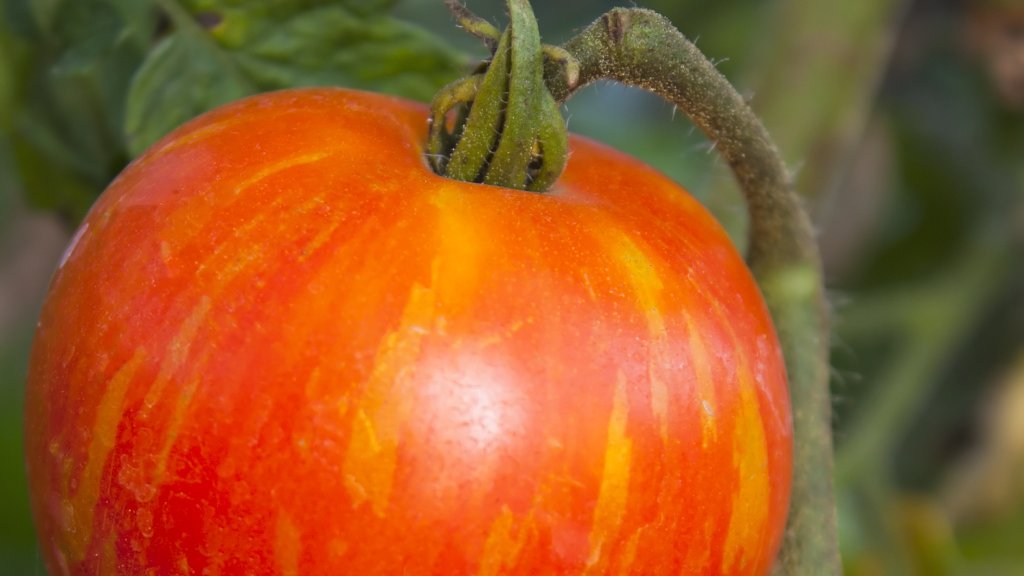History Of Tigerella Heirloom Tomatoes

I love tomatoes and attempt to grow them every year with varying degrees of success. I attribute my failures to the general short growing season here in the Pacific Northwest. That is, rather the lack of sun! Apparently, there is a fabulous heirloom cultivar that might break my record of losses to successes. I haven't grown these yet, but by all accounts I should. What am I talking about? Tigerella heirloom tomatoes. Why should I grow them? Read on to learn about the history of Tigerella tomatoes and other useful Tigerella tomato information.
History of Tigerella Tomatoes
Tigerella heirloom tomatoes were developed in the 1950's by Dr. Lewis Darby of Great Britain, maybe. Other sources state that Tigerella tomato seeds were bred by the Glasshouse Research Institute in England in the 1930's as a cross between an unknown cultivar and Ailsa Craig. Regardless, it is an heirloom tomato (called a heritage tomato in the UK) that produces small silver-dollar sized fruit with reddish-orange skin dappled with golden to golden-green striping. The flesh is tangy-sweet with a similar striking coloration. It is an indeterminate type of tomato that requires staking and yields prodigious amounts of fruit. Tigerella tomatoes are sometimes called Tiger Tom or Mr. Stripey. While Tigerella tomatoes may very well be the same old English greenhouse Tiger Tom tomatoes, Mr. Stripey tomatoes are not related. Mr. Stripey is a bicolor beefsteak tomato; much larger than either Tigerella or Tiger Tom. Mr. Stripey is notable for its unusually tiny leaves and combination of yellow/red coloration. Tiger Tom tomatoes were popular late 19th century heirlooms that waned in popularity. Ben Quisenberry of Syracuse, Ohio ran heirloom seed savers "Big Tom Gardens" from 1910 to 1986, where he rediscovered the variety and saved it from extinction. Then, through a twist of fate, the seeds were lost again only to be rediscovered more recently by Kent Whealy of Seed Savers Exchange. Confused yet? I am, and it just gets more confusing. Apparently, the English version of Tigerella is known as "Mr. Stripey" there, though not to be confused with the United States' Mr. Stripey. Anyhoo, the Latin name you are looking for is Lycopersicon esculentum 'Tigerella.'
Tigerella Tomato Information
Okay, now that I have succeeded in completely flummoxing you regarding exactly what the name of this small, tiger striped tomato is, what useful information can I impart regarding Tigerella tomato seeds and fruit? Tigerella is an annual, open pollinated tomato that produces juicy tart to sweet fruit. The small (2 inches) fruit is fun to grow with kids but the adults will love them in salads or eaten raw like an oversized cherry tomato. Plant Tigerella tomato seeds in a full sun site after all possibility of freezing has passed or start seeds inside 6 weeks prior to the last frost. Transplant seedlings when they are 6 inches tall in loamy soil with a pH of between 5.0 and 6.0. Harden off the plants gradually over the course of a week or so prior to transplanting. Don't transplant until soil temps are at least 50 degrees F. (10 C.) at night. Keep the transplants moist. Fertilize with a low nitrogen fertilizer to encourage fruit set. Plant will need staking, so think ahead and provide a structure or cage for it to grow on. Fruit matures early, within 60-70 days, and is ready to pluck directly from the vine to enjoy in all its juicy, sun warmed glory. Fruit is apparently prone to cracking, however, but what's a little cracking amongst friends. Yum! I think I've talked myself into growing Tigerella. I'll let you know how it goes.
Gardening tips, videos, info and more delivered right to your inbox!
Sign up for the Gardening Know How newsletter today and receive a free copy of our e-book "How to Grow Delicious Tomatoes".

Amy Grant has been gardening for 30 years and writing for 15. A professional chef and caterer, Amy's area of expertise is culinary gardening.
-
 Grow ‘Karl Rosenfield’ Peony Plants For The Ultimate Frilly Border Beauties And Cut Flowers
Grow ‘Karl Rosenfield’ Peony Plants For The Ultimate Frilly Border Beauties And Cut FlowersFor frilly double magenta peony petals infused with a heady fragrance, grow ‘Karl Rosenfield’ peony plants. Here’s how to cultivate the ultimate plushy blooms
By Tonya Barnett
-
 10 Common Composting Problems That Can Spoil Your Garden Gold – Plus Easy Fixes
10 Common Composting Problems That Can Spoil Your Garden Gold – Plus Easy FixesLearn how to troubleshoot common composting issues before they ruin your stash – from bad smells and bugs to materials not breaking down as they should.
By Susan Albert